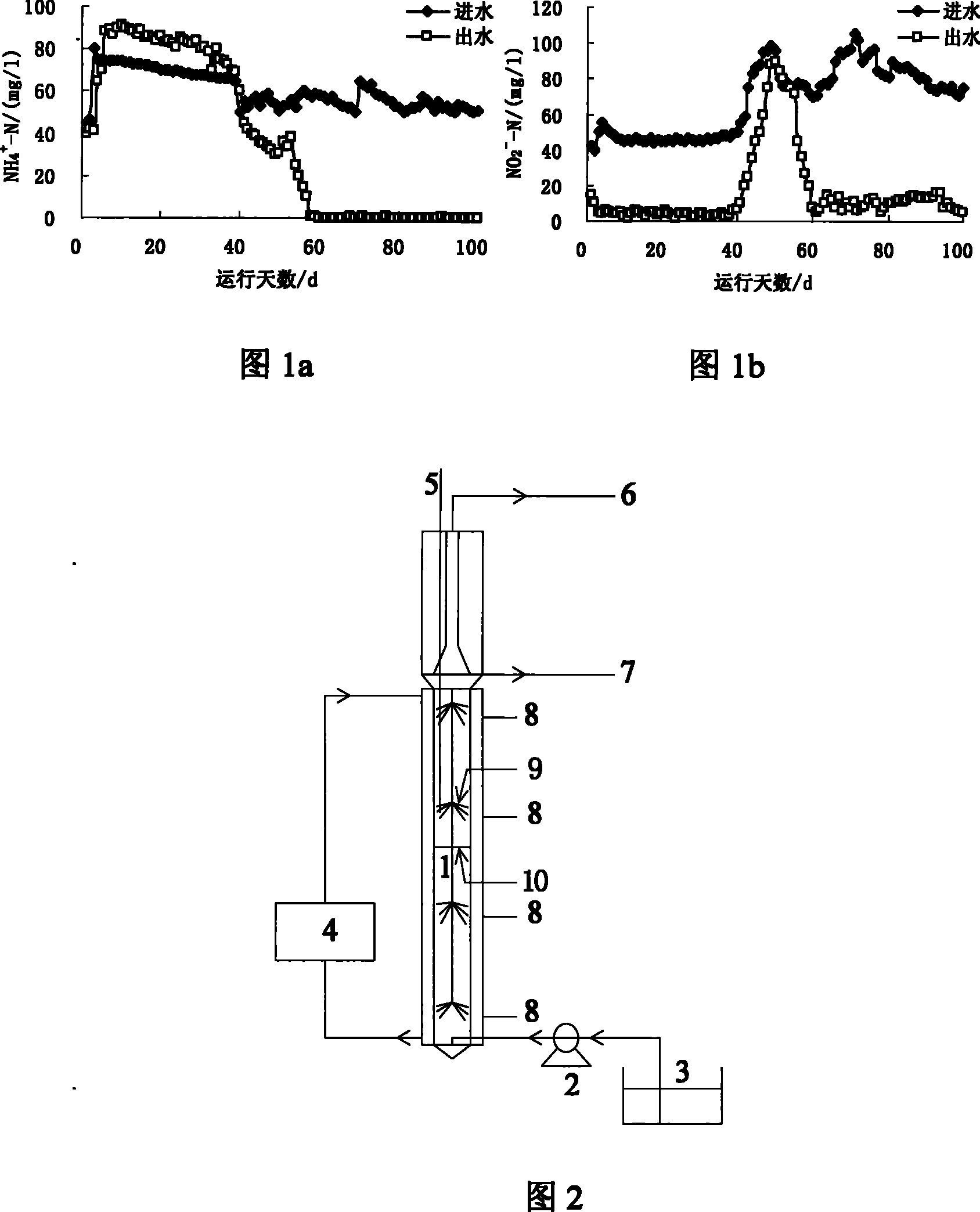Method for rapidly culturing anaerobic ammonium oxidation bacteria by up-flow type anaerobic sludge bed reactor
A technology of anammox bacteria and flow anaerobic sludge, which is applied in the field of anammox bacteria cultivation, can solve the problems of unstable operation of the reactor, slow bacterial growth, long acclimation time, etc., and achieves stable operation, High nitrogen removal rate and good nitrification effect
- Summary
- Abstract
- Description
- Claims
- Application Information
AI Technical Summary
Problems solved by technology
Method used
Image
Examples
Embodiment 1
[0023] (a) In the UASB reactor, the biofilm can effectively retain the enriched microorganisms, and the cultivation of the biofilm is conducive to the accumulation of ANAMMOX bacteria. The inoculum sludge is taken from the activated sludge in the leachate SBR process of a landfill site. The sludge is reddish brown. The ordinary optical microscope inspection shows that the sludge structure is finely divided, and there are bell worms, larvae and rotifers. There are few filamentous bacteria, MLSS is 55.63g / L, and the inoculation amount is 65% of the effective volume of the reactor. The SBR process itself has the characteristics of process operation, including anaerobic, anoxic, aerobic and static stages, and sludge When the nitrification effect of the SBR process is good, there are a variety of microorganisms in the inoculated sludge from the aerobic SBR process for treating landfill leachate, which is conducive to accelerating the enrichment of anammox bacteria. Dissolved oxygen...
Embodiment 2
[0027] (a) In the UASB reactor, the biofilm can effectively retain the enriched microorganisms, and the cultivation of the biofilm is conducive to the accumulation of ANAMMOX bacteria. The inoculum sludge is taken from the activated sludge in the leachate SBR process of a landfill site. The sludge is reddish brown. The ordinary optical microscope inspection shows that the sludge structure is finely divided, and there are bell worms, larvae and rotifers. There are few filamentous bacteria, MLSS is 50.23g / L, and the inoculation amount is 60% of the effective volume of the reactor. The SBR process itself has the characteristics of process operation, including anaerobic, anoxic, aerobic and static stages, and sludge When the nitrification effect of the SBR process is good, there are a variety of microorganisms in the inoculated sludge from the aerobic SBR process for treating landfill leachate, which is conducive to accelerating the enrichment of anammox bacteria. Dissolved oxygen...
Embodiment 3
[0031] (a) In the UASB reactor, the biofilm can effectively retain the enriched microorganisms, and the cultivation of the biofilm is conducive to the accumulation of ANAMMOX bacteria. The inoculum sludge is taken from the activated sludge in the leachate SBR process of a landfill site. The sludge is reddish brown. The ordinary optical microscope inspection shows that the sludge structure is finely divided, and there are bell worms, larvae and rotifers. There are few filamentous bacteria, MLSS is 59.67g / L, and the inoculation amount is 70% of the effective volume of the reactor. The SBR process itself has the characteristics of process operation, including anaerobic, anoxic, aerobic and static stages, and sludge When the nitrification effect of the SBR process is good, there are a variety of microorganisms in the inoculated sludge from the aerobic SBR process for treating landfill leachate, which is conducive to accelerating the enrichment of anammox bacteria. Dissolved oxygen...
PUM
 Login to View More
Login to View More Abstract
Description
Claims
Application Information
 Login to View More
Login to View More - R&D
- Intellectual Property
- Life Sciences
- Materials
- Tech Scout
- Unparalleled Data Quality
- Higher Quality Content
- 60% Fewer Hallucinations
Browse by: Latest US Patents, China's latest patents, Technical Efficacy Thesaurus, Application Domain, Technology Topic, Popular Technical Reports.
© 2025 PatSnap. All rights reserved.Legal|Privacy policy|Modern Slavery Act Transparency Statement|Sitemap|About US| Contact US: help@patsnap.com

